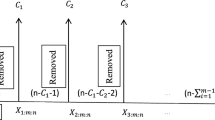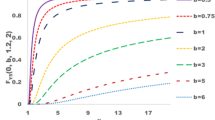Abstract
Proportional reversed hazard rate distribution family plays an important role in the reliability and lifetime data modelling. In this manuscript this family of distributions is generalized in order to enhance its modelling capability. Considering a special case, we introduce the extended generalized exponential distribution. Its mathematical properties are also studied. New model is applied in fitting levels of TSH hormone and remission times of bladder cancer patients. We believe these results may attract applied statisticians especially those who are in charge with life time data analysis.





Similar content being viewed by others
References
Andersen P, Borgan O, Gill R, Keiding N (1993) Statistical models based on counting processes. Springer, New York
Andersen P, Borgan O, Gill R, Keiding N (2009) Continuous bivariate distributions, 2nd edn. Springer, New York
Arnold B, Beaver R (2000) Hidden truncation models. Sankhya Ser A 62:23–35
Azzalini A (1985) A class of distributions which includes the normal ones. Scand J Stat 12:171–178
Block H, Savits T, Sing H (1998) The reversed hazard rate function. Probab Eng Inform Sci 12:69–90
Burr I (1942) Cumulative frequency distribution. Ann Math Stat 13:215–232
Chandra S (1977) On the mixtures of probability distributions. Scand J Stat 4(3):105–112
Chechile R (2011) Properties of reverse hazard functions. J Math Psychol 55:203–222
Cordeiro G, Gomes A, da Silva C, Ortega E (2017) A useful extension of the Burr iii distribution. J Stat Distrib App 4(24):1–15
Cox D (1972) Regression models and life-tables. J Roy Stat Soc B Met 34:187–220
Di Crescenzo AD (2000) Some results on proportional reversed hazard rate function. Stat Probab Lett 50:313–321
Domma F, Popovic B, Nadarajah S (2015) An extension of Azzalini’s method. J Comput Appl Math 278:37–47
Domma F, Condino F, Popovic B (2017) A new generalized weighted Weibull distribution with decreasing, increasing, upside-down bathtub, N-shape and M-shape hazard rate. J Appl Stat 44:2978–2993
Everitt B (2002) A handbook of statistical analysis using S-plus, 2nd edn. Chapman Hall/CRC, Boca Raton
Finkelstein M (2002) On the reversed hazard rate function. Reliab Eng Syst Safe 78:71–75
Gross S, Huber-Carol C (1992) Regression models for truncated survival data. Scand J Stat 19:193–213
Guillaume R, François D (2014) Learning negative mixture models by tensor decompositions. arXiv:1403.4224
Gupta C, Gupta R (2007) Proportional reversed hazard rate model and its applications. J Stat Plan Infer 137:3525–3536
Gupta R, Kundu D (1999) Generalized exponential distributions. Aust N Z J Stat 41:173–188
Gupta R, Nanda A (2001) Some results on reversed hazard rate ordering. Commun Stat Theor Methods 30:2447–2457
Gupta R, Gupta R, Gupta P (1998) Modeling failure time data by Lehman alternatives. Commun Stat Theor Methods 27:887–904
Kalbfleisch J, Lawless J (1989) Inference based on retrospective ascertainment: an analysis of the data on transfusion-related aids. J Am Stat Assoc 84:360–372
Lawless J (2000) Introduction to two classics in reliability theory. Technometrics 42:5–6
Lee C, Famoye F, Olumolade O (2000) Beta-Weibull distribution: some properties and applications to censored data. J Mod Appl Stat Methods 6(1):173–186
Lee E, Wang J (2003) Statistical methods for survival data analysis, 3rd edn. Wiley, New York
Marshall A, Olkin I (1967) A generalized bivariate exponential distribution. J Appl Probab 4:291–302
Marshall A, Olkin I (2007) Life distributions: structure of nonparametric, semiparametric, and parametric families. Springer, New York
Mudholkar G, Srivastava D (1993) Exponentiated Weibull family for analyzing bathtub failure-rate data. IEEE Trans Reliab 42:299–302
Muhammed H (2020) On a bivariate generalized inverted Kumaraswamy distribution. Physica A 553:124281
Popović BV, Ristić MM, Genç Aİ (2020) Dependence properties of multivariate distributions with proportional hazard rate marginal. Appl Math Model 77:182–198
R Core Team (2020) R: a language and environment for statistical computing. R Foundation for Statistical Computing, Vienna, Austria. http://www.R-project.org/
Ross S, Shanthikumar J, Zhu Z (2005) On increasing failure rate random variables. J Appl Probab 42:797–806
Sankaran P, Gleja V (2008) Proportional reversed hazard and frailty models. Metrika 68:333–342
Sarabia J, Jorda V, Prieto F (2019) On a new Pareto-type distribution with applications in the study of income inequality and risk analysis. Physica A 527:121277
Shaked M, Shanthikumar J (1994) Stochastic orders and their applications. Academic Press, New York
Titterington D, Adrian F, Makov U (1985) Statistical analysis of finite mixture distributions. Wiley, New York
Topp C, Leone F (1955) A family of J-shaped frequency functions. J Am Stat Assoc 50:209–219
Veres-Ferrer E, Pavia J (2014) On the relationship between the reversed hazard rate and elasticity. Stat Pap 55:275–284
Wolfram Research (2012) Mathematica, Version 9.0. https://www.wolfram.com/mathematica
Zea L, Silva R, Bourguignon M, Santos A, Cordeiro G (2012) The beta exponentiated pareto distribution with application to bladder cancer susceptibility. Int J Stat Probab 1:8–19
Acknowledgements
The authors wish to thank an associate editor and three anonymous reviewers for their valuable comments and suggestions which helped to improve the presentation of this paper.
Author information
Authors and Affiliations
Corresponding author
Ethics declarations
Conflict of interest
The authors declare that they have no conflict of interest.
Additional information
Publisher's Note
Springer Nature remains neutral with regard to jurisdictional claims in published maps and institutional affiliations.
Appendices
Appendix A. Proof of the Theorem 1
The conditional CDF of the random variable \(X=Z|Y\le 1\) is
Using the result obtained in Lemma 2 and by substitution \(G(x;\varvec{\xi })=u,\) the marginal PDF of the random variable Y is obtained as
where \(Q(u;\varvec{\xi })=G^{-1}(u;\varvec{\xi })\,.\)
Now we need to calculate \(F_Y(1)=P\left\{ Y<1\right\} .\) So,
Using \(G(Q(u;\varvec{\xi });\varvec{\xi })=u\), we easily find
Using substitution \(G(yz;\varvec{\xi })=u\), one can obtain
Finally we have
The interchanging the order of integration is allowed by Tonelli’s theorem.
By combining (14)–(15), we obtain the CDF of \(X=Z|Y\le 1.\) If we differentiate it with respect to x, one can verify that the conditional PDF \(f_{X=Z|Y\le 1}(x; \varvec{\alpha }, \theta ,\varvec{\xi } )\) coincides with (5).
Appendix B. The likelihood equations
for \(j=1,\dots ,q\), where
and
Rights and permissions
About this article
Cite this article
Popović, B.V., Genç, A.İ. & Domma, F. Generalized proportional reversed hazard rate distributions with application in medicine. Stat Methods Appl 31, 459–480 (2022). https://doi.org/10.1007/s10260-021-00583-5
Received:
Revised:
Accepted:
Published:
Issue Date:
DOI: https://doi.org/10.1007/s10260-021-00583-5
Keywords
- Generalized proportional reversed hazard rate
- Extension of Azzalini’s method
- Farlie–Gumbel–Morgenstern copula function
- Hidden truncation
- Application in medicine




